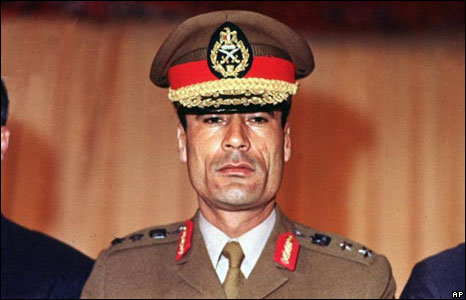Only a mad man would nationalize oil.
Only a mad man would spend billions of the oil money to provide clean water to his desert people.
Only a mad man would use that water to turn the desert into agricultural land with the potential to rival the production of California.
Only a mad man would encourage marriage by giving newly-weds money to buy a home.
The Mad Man is Dead. Long live the Mad Man!
In 1953 while drilling for oil in southern Libya, workers found instead a huge freshwater sea beneath the sands, a vast ocean called the Nubian Sandstone Aquifer System (NSAS), which stretches beneath Libya, Egypt, Chad and Sudan. The water had accumulated during the last ice age. Its reserves are estimated to be the equivalent to about 500 years of Nile River flow and are expected to last a thousand years.
THE GREAT MAN-MADE RIVER
Western technicians said that Libya did not have the expertise to exploit this underground ocean; but in the early 1980s Colonel Muammar Gaddafi initiated the Great Man-Made River Authority, a 25-billion-dollar project to raise the water and pipe it across the desert. Expertise and equipment was imported from Italy, Spain, Germany, Japan and South Korea. The first water began to flow in September 1989 and the project is nearing completion this year, 2011.
It is already the world’s largest irrigation project and the largest underground network of pipes and aqueducts. It supplies 6,500,000 cubic metres of fresh water daily. From being one of the driest countries on earth, the Libyan desert is now blooming.
LIBYA HAS WATER TO GREEN THE DESERT
by Simba Russeau, Guardian, May 27, 2011
With only five percent of the country getting at least 100 millimetres of rainfall per year, Libya is one of the driest countries in the world. Historically, coastal aquifers or desalination plants located in Tripoli were of poor quality due to contamination with salt water, resulting in undrinkable water in many cities including Benghazi. Oil exploration in the southern Libyan desert in the mid-1950s revealed vast quantities of fresh, clean groundwater - this could meet growing national demand and development goals. Scientists estimate that nearly 40,000 years ago when the North African climate was temperate, rainwater in Libya seeped underground forming reservoirs of freshwater.
In 1983, Libyan leader Muammar Gaddafi initiated a huge civil water works project known as the Great Man-Made River (GMMR) - a massive irrigation project that drew upon the underground basin reserves of the Kufra, Sirte, Morzuk, Hamada and the Nubian Sandstone Aquifer - to deliver more than five million cubic metres of water per day to cities along Libya's coastal belt.
"The Colonel's GMMR [Great Man-Made River] project was discounted when first unveiled as an uneconomic flight of fancy and a wasteful exploitation of un-renewable freshwater reserves," Middle East-based journalist Iason Athanasiadis told IPS. "But subsequently it was hailed as a masterful work of engineering, tapping into underground aquifers so vast that they could keep the 2007 rate of dispersal going for the next 1,000 years." Lying beneath the four African countries Chad, Egypt, Libya and Sudan, the Nubian Sandstone Aquifer System (NSAS) is the world's largest fossil water aquifer system, covering some two million square kilometres and estimated to contain 150,000 cubic kilometres of groundwater. Fossil water is groundwater that has been trapped in underground fossil aquifers for thousands or even millions of years....
"The GMMR [Great Man-Made River] provides 70 percent of the population with water for drinking and irrigation, pumping it from Libya's vast underground aquifers like the NSSA [Nubian Sandstone Aquifer System] in the south to populated coastal areas 4,000 kilometres to the north," Ivan Ivekovic, professor of political science at the American University of Cairo told IPS. "The entire project was drawn out over five phases. Phase one took water from eastern pipelines in As-Sarir and Tazerbo to Benghazi and Sirte; phase two supplied water in Tripoli and western pipelines in Jeffara from the Fezzan region; and phase three intended to create an integrated system and increase the total daily capacity to almost four million cubic metres and provide up to 138,000 cubic metres per day to Tobruk." With an estimated cost of nearly 30 billion dollars, the GMMR's network of nearly 5,000 kilometres of pipeline from more than 1,300 wells drilled up to 500 metres deep into the Sahara was also intended to increase the amount of arable land for agricultural production.
"Libya could start an agro-business similar to California's San Joaquin Valley. Like Libya, California is essentially desert but because of irrigation and water works projects that desert valley became the largest producer of food and cotton in the world, making it the ninth largest economy in the world," Patrick Henningsen, 21st Century Wire editor and founder, told IPS. "At the moment the only agro-markets in the Mediterranean zone competing to supply citrus and various other popular supermarket products to Europe are Israel and Egypt. In 10 or 20 years, Libya could surpass both of those countries because they now have the water to green the desert."...
Blogger's Note: Thank you Bruce. It seems even the worst of us manage to do some good - although, the jury is still out on W.

No comments:
Post a Comment